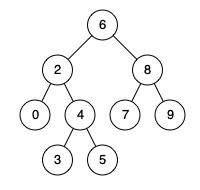235. Lowest Common Ancestor of a Binary Search Tree
Problem
Tags: Tree, Depth-First Search, Binary Search Tree, Binary Tree
Given a binary search tree (BST), find the lowest common ancestor (LCA) of two given nodes in the BST.
According to the definition of LCA on Wikipedia: “The lowest common ancestor is defined between two nodes p and q as the lowest node in T that has both p and q as descendants (where we allow a node to be a descendant of itself).”
Example 1:

Input: root = [6,2,8,0,4,7,9,null,null,3,5], p = 2, q = 8
Output: 6
Explanation: The LCA of nodes 2 and 8 is 6.
Example 2:

Input: root = [6,2,8,0,4,7,9,null,null,3,5], p = 2, q = 4
Output: 2
Explanation: The LCA of nodes 2 and 4 is 2, since a node can be a descendant of itself according to the LCA definition.
Example 3:
Input: root = [2,1], p = 2, q = 1
Output: 2
Constraints:
- The number of nodes in the tree is in the range
[2, 10^5]. -10^9 <= Node.val <= 10^9- All
Node.valare unique. p != qpandqwill exist in the BST.
Code
JS
// 235. Lowest Common Ancestor of a Binary Search Tree (6/12/53748)
// Runtime: 136 ms (15.89%) Memory: 48.54 MB (93.21%)
/**
* Definition for a binary tree node.
* function TreeNode(val) {
* this.val = val;
* this.left = this.right = null;
* }
*/
/**
* @param {TreeNode} root
* @param {TreeNode} p
* @param {TreeNode} q
* @return {TreeNode}
*/
function lowestCommonAncestor(root, p, q) {
if (root.val > p.val && root.val > q.val) return lowestCommonAncestor(root.left, p, q);
else if (root.val < p.val && root.val < q.val) return lowestCommonAncestor(root.right, p, q);
else return root;
}